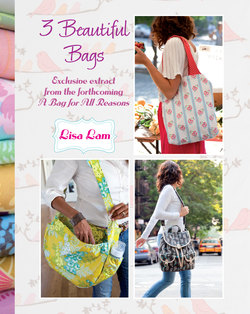Читать книгу 3 Beautiful Bags - Lisa Lam - Страница 7
ОглавлениеMachine feet
There are various feet required for different kinds of stitches and applications, so
you need to think about the stitches you want to use and research to see which
types of feet are appropriate for your needs. If you are about to purchase a sewing
machine, see which feet are supplied with the machine, then ask the dealer if they
will throw in some extra feet for free (and ask about any other freebies too!).
Standard presser foot – this is the foot that you will
make the most use of. With this versatile foot you can
sew straight and zigzag stitch, and the majority of the
more decorative stitches too.
Clear presser foot – this is a standard presser foot,
but instead of being metal, it’s made from transparent
plastic, which makes seeing things like notches and
markings on your fabric so much easier.
Piping foot – if you’re going to sew with any amount
of piping, a piping foot is a must.
Zipper foot – makes sewing very close to the edge of an
item much easier, and is also essential for sewing zips.
Non-stick foot – this foot is brilliant for ‘sticky’ fabric
such as laminated cotton, oilcloth, vinyl and leather.
Seam allowance guide – this is not a foot, but is a
handy metal edge that screws to the bed of the machine
and is very useful for professional-looking topstitching.
Set your desired seam allowance on the guide, then butt
the edge of your work to the seam allowance guide and
away you go.
✧
✧
✧
✧
✧
✧
Machine stitches
I’ve been making bags for over eight years and in
that time I’ve only ever used two machine stitches.
Zigzag stitch – every now
and again I use zigzag to
stitch over the raw edges
of fabric to prevent it
from fraying.
Straight stitch – this is
basically the only stitch
I ever really use.
Getting Started
standard
presser foot
clear
presser foot
piping foot
non-stick foot
zipper foot
seam
allowance
guide
